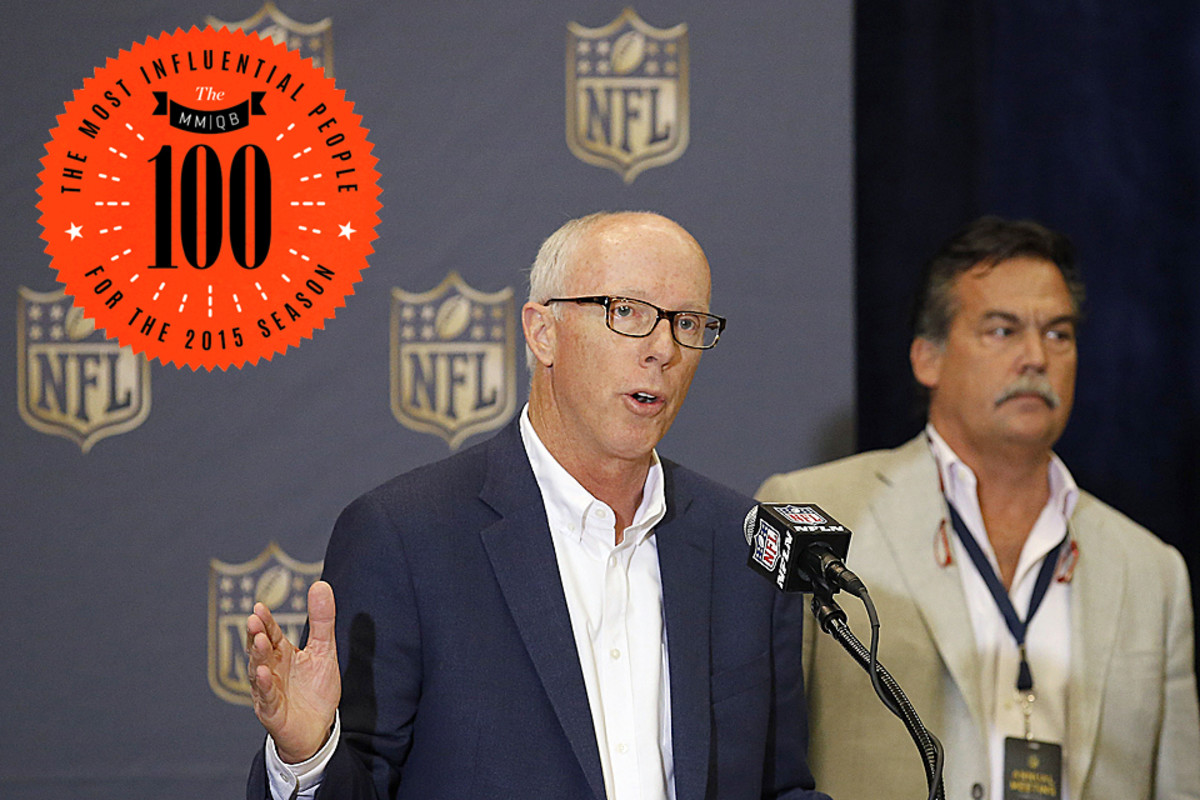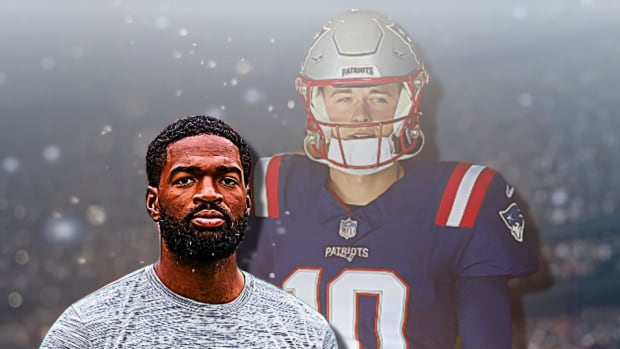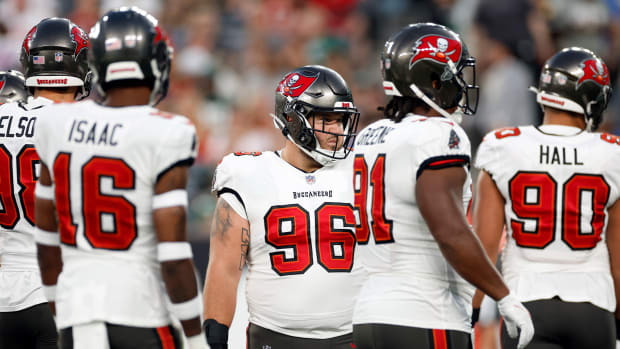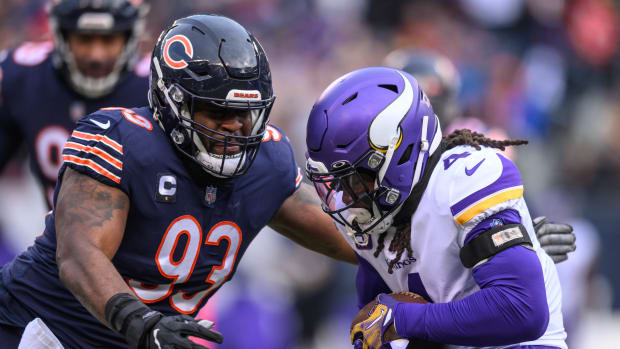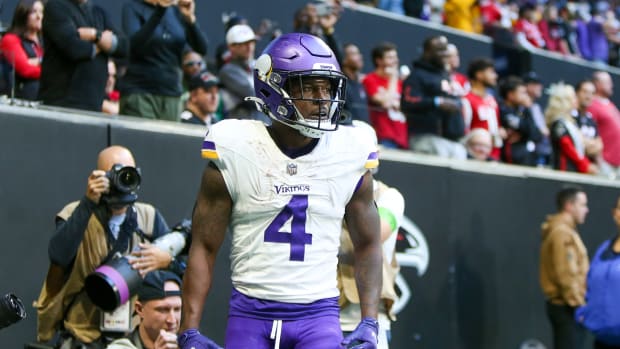No. 10: Rich McKay
Editor’s note: This is part of our summer series, The MMQB 100, counting down the most influential people for the 2015 season.
The story about the 10th-most influential person of the 2015 NFL season is not altogether a story about NFL Competition Committee co-chairman Rich McKay. After all, it’s likely that anyone who has clicked onto this story has already said: “Rich McKay? No. 10? The MMQB has lost its mind.”
Well, that last sentence might be fair. But McKay is No. 10 because he represents the biggest change to football’s scoring system in the last 103 years. (In 1912, eight years before the birth of professional football in the United States, the touchdown was changed from five to six points, a two-point safety was added, and the field goal and point-after-touchdown were retained at three and one points, respectively.)
McKay is the president and CEO of the Atlanta Falcons, but he’s on this list because of his role as the czar of the Competition Committee, the rules-making body that status-quo seekers have been seething about in recent years—this year, especially—because of the tinkering the committee has done. In recent years it has recommended, and gotten approval for, changes to overtime and the kickoff (moving it up to decrease the number of kick returns, out of safety considerations). This offseason it made the extra point a slightly more challenging kick. League owners, cognizant of the 99.5% success rate on PATs over the past four seasons, voted 30-2 in May to move the extra-point line of scrimmage from the two- to the 15-yard line. That will make the extra point a 32- or 33-yard kick (less of a gimme, but not much less). That will also, league officials hope, spur more two-point conversion tries. Last season there were only 59 of those.
Now, this spring McKay was suspended from the Competition Committee because the Falcons were found to have pumped in artificial crowd noise during home games. As the club CEO, McKay wasn’t found to have any role in the crowd-noise issue, but commissioner Roger Goodell suspended him because he was the club executive in charge of such things. It was a misleading suspension, seeing that McKay was still allowed to lobby teams on Competition Committee business; he just had to do it strictly as a Falcons executive. And with some explicatory and gentle arm-twisting by McKay and others on the committee, there was enough movement by teams that had, for years, not supported the change to the PAT.
The passage of this scoring rule (thanks to McKay’s mastery of the glacial movement of NFL rules reform) is why McKay is on this list. (If there was any evidence McKay was involved in the crowd-noise funny business, The MMQB would not have put him here.)
This is a nod to McKay’s influence in the rules-making process. This installment is going to be less about one man than it is about the way a rule change came about that so many in the league, particularly coaches, did not want to see. How can a man who is not even on the Falcons’ football-operations side—McKay’s charge from Atlanta owner Arthur Blank these days is to oversee the sale and the construction of the team’s new open-air stadium in Atlanta—be so influential in making the rules of the game?
It’s because he’s a deft politician. And because he’s not afraid to push to change a rule, even if that rule is 103 years old.
Amending a rule in a conservative league like the NFL takes time. Patience and time. When McKay took over as the co-chair of the committee from the late George Young in 1998, Young told him not to try to force change. It just wouldn’t work. First, coaches don’t like to be told what to do, or what rules to change, by executives. A couple of years ago, then-Jets coach Rex Ryan was adamant that he didn’t want to change the overtime rules. While most of his peers eventually came around because the coin flip was weighing too heavily on the outcome of games (nearly six in 10 overtime games in the 10 years before the change were won on the first possession), Ryan didn’t. So the committee had to find coaches and owners willing to change. In 2012, “modified overtime” became the rule for all games (it was a postseason-only rule the previous two seasons), with each team getting at least one offensive possession if the first possession didn’t end in a touchdown or safety.
The process to change overtime took four years. McKay was not surprised. Young told him long ago: Be patient. Listen. Don’t be afraid of change, but don’t force anyone to adopt your way of thinking. Let things marinate if you have to.
There’s no better example of letting things marinate than the extra-point debate. It took nine years of Competition Committee jousting to push the change through.
* * *
Introducing The MMQB’s ranking of the most influential figures for the 2015 season. THE LIST SO FARNos. 11-20: Amy Trask, the first female CEO in NFL history, on what Sarah Thomas, the league’s first female official, will face in her first season. Plus, Watt, Luck, Peterson and Robert Kraft. FULL STORYNos. 21-30: How Sam Bradford fits into Chip Kelly’s master plan. Plus, RG3, Brees, Rex Ryan and Suh. FULL STORYNos. 31-40: Long essay on Odell Beckham Jr., who is poised to take over the NFL in 2015, plus, Jimmy Graham, Andy Dalton, Gronk and more. FULL STORYNos. 41-50: Long essay on Mark Rodgers, the man negotiating Russell Wilson's new contract, plus Richard Sherman, Jimmy Garoppolo and more. FULL STORYNos. 51-60: Long essay on Bears QB Jay Cutler. Plus, Cam Newton, NaVorro Bowman, DeMarco Murray and more. FULL STORYNos. 61-70: Long essay on the late Junior Seau. Plus, Darrell Bevell, Cris Collinsworth and more. FULL STORY
It was in 2006 that committee member Mike Brown, the Bengals’ owner, suggested the league do away with the near-automatic PAT and simply make a touchdown worth seven points. Brown, normally in the conservative corner, did have a bit of his father’s (Paul Brown) imagination. But rules changes take 24 yes votes from the league’s 32 owners to pass, and there was nothing close to that for several years after Brown’s idea surfaced.
But with NFL kickers as accurate as Army Ranger sharpshooters, the move toward a PAT change began to gain momentum. For the last two or three years, Goodell has pushed it. The committee thought there was a chance in 2014, when the argument was advanced that, over the previous three seasons, one PAT was missed every 44 games. In the league meeting that year, owners, meeting with the Competition Committee, were asked, “Does anyone here think the extra point is a competitive play?” Not a single owner or owner’s representative said it was. That was a turning point.
This year, though, the Competition Committee came to the league meetings in Arizona thinking it couldn’t advance a proposal to get 24 votes. That’s when Goodell, on the Sunday night before the meetings began, told the eight members of the committee, in effect: We’ve talked about this for years. You know we can’t have a play that’s strictly ceremonial. You’ve got to figure out the best alternative to make the play mean something.
McKay knew that pushing the extra point back 13 yards wouldn’t be revolutionary. Kickers made 95% of their field-goal tries from 32- and 33-yards over the past two seasons. He also knew owners and coaches wouldn’t stand for the dissolution of the extra point. And by pushing it back to where it would be a real challenge—say, line of scrimmage at the 27-yard line—the football establishment would have rebelled and no rule change would have had a chance.
So, quietly, McKay pushed for a one-year trial. He knew that would soften the issue for those who weren’t in favor of changing anything about the scoring system. But he also knew that it would make it possible in 2016 (or 2017, after another one-year passage in 2016) to push the line back another five yards. Or 10. The reality is, the league would like to see two years of data before making another change in where the PAT is kicked from. But if the PAT succeeds at a 98% rate in 2015 with no major increase in two-point tries, it’s not impossible that the line could get pushed back in 2016 (with the approval of 24 teams, of course).
That’s the key. Years of experience have taught McKay that fine-turning the PAT a little bit at a time is what is needed.
What’s interesting about the resolution of this case, which could well have been controversial, is that it was not controversial. When the measure came up for debate at the Ritz-Carlton Hotel in San Francisco in May, it was discussed for about a half hour. Owners knew they’d make a change going into the meeting. They just didn’t know how big a change they’d make. The Eagles wanted the two-point play to be snapped from the one-yard line instead of the two-; that was a non-starter because of the risk of injury to quarterbacks getting whacked by big linebackers on sneaks. The Patriots wanted to make it a permanent rule, with no chance for defensive points to be scored on failed PAT or two-point tries. But the owners liked the idea of the excitement of the defensive return (similar to the college rule) for points, and liked the two-point try to be from two yards out.
The reason there was little debate is that the Competition Committee didn’t try to shove the rule down the league’s throat. Goodell favored it and was forceful about it but let the committee do its job. That’s the way a democratic process should work, McKay knows, with some marination.
Football, 24/7
Keep up with the latest from Peter King and The MMQB.
Two final points that McKay knew would be attractive to fans, and to some teams:
• There’s something good about more strategy in the game. Once foul weather comes into play in some stadiums, and the wind is howling or the snow is coming down, coaches are going to have some decisions to make. Let’s say it’s Week 17 at Lambeau Field, Jan. 2. A 23-mph wind blows across the field, and Vikings coach Mike Zimmer has to make a call after a fourth-quarter touchdown brings his team to within 28-20. Send Blair Walsh out to try a 33-yard PAT through the wind? Or spread the field with four wides and Adrian Peterson set behind Teddy Bridgewater and go for two? Now the coach has a decision to make—and there’s more intrigue in the game.
• Rosters could have some intrigue too. Baltimore coach John Harbaugh is likely to have the moderately athletic Joe Flacco and a statue, Matt Schaub, as his quarterbacks. Tom Coughlin could keep two pocket passers, Eli Manning and Ryan Nassib. Would the Ravens or Giants be tempted to keep a third quarterback and 53rd man on the roster to be either the permanent or occasional two-point-conversion pilot? Will any team do that? I asked one coach who hates the new rule—he doesn’t like to have another decision to make, particularly one that might cost him a game—and he said that as much as he doesn’t want this rule to impact his roster, he’d consider keeping a mobile third quarterback if his first two were not movement players.
So Rich McKay and his committee have given coaches, GMs and fans something to think about, and he did it by changing a rule that many of us never thought would change. That’s why he cracked our top 10.
CLICK HERE TO SEE THE MMQB 100 SO FAR...
10. Rich McKay, Co-Chairman, NFL Competition Committee
It had been more than a century since there was a major alteration to football’s scoring system. So when Rich McKay and the Competition Committee convinced the owners to change the extra point, it was no small feat. Nor was it an easy process. FULL STORY
* * *
9. Peyton Manning, Quarterback, Denver Broncos
Last year, Peyton Manning had a terrific regular season that was overshadowed by an ugly playoff exit. Also, the U.S. government collected taxes in mid-April, no mail was delivered on Labor Day and Thanksgiving took place on the fourth Thursday in November. Business as usual.
It’s from this that Manning is often described as “the greatest-regular season quarterback of all time.” This, of course, is a subtly brutal backhanded compliment—like the person you’re in love with telling you what an amazing friend you are.
As much as Manning hates the backhandedness—and he does hate it—in a way, it’s a testament to the level of respect people have for him. We regard Drew Brees as a future Hall of Famer without caring that he’s only been to one Super Bowl. Aaron Rodgers also has only one Super Bowl ring. So does Brett Favre. And Kurt Warner. And Joe Namath. And Steve Young (as a starter).
The closer it’s scrutinized, the more ridiculous the disparagements of winning “only one Super Bowl” become. Deep down, we know Super Bowls aren’t the be-all, end-all. (Need proof? How many arguments have you heard for Eli being the best quarterback in the Manning family?) But for some reason, any postseason that ultimately ends in a loss is chalked up as a Manning choke job, even though the postseason ends in a loss for all but one quarterback every year. And some HOF and future HOF quarterbacks have had years when they didn’t even reach the postseason. (Hey, there’s an idea for Manning. After all, a QB can’t choke if he has nothing to chew on.)
Last year’s loss to the Colts was the latest postseason “choke.” Manning played poorly that afternoon. So did his receivers, who suddenly forgot how to separate from man coverage. And so did his offensive linemen, who incurred a handful of costly brain cramps. But instead of examining that, it’s easier to examine Manning’s age—38 at the time—and decree that Father Time has him on the ropes.
Fortunately, John Elway, current Broncos GM and another quarterback who, until the last two years of his career, lived under the unfair burden of near-impossible postseason standards, didn’t hit the panic button in regards to Manning. Obviously, Elway felt the Broncos underachieved in 2014. Otherwise he wouldn’t have fired the coaching staff and hired new head man Gary Kubiak, who is expected to eventually overhaul the offensive scheme. But Elway never considered dumping Manning. He did persuade the 18-year vet to defer $4 million of his $19 million salary into incentives based on playoff victories. But for a megamillionaire QB, this was like spotting the club a twenty.
As Super Bowl chances go, the ’15 Broncos appear to be the least equipped of Manning’s four Broncos clubs. The defense is loaded, sure, but the offense has been decimated by free agency (TE Julius Thomas, G Orlando Franklin) and, already, injuries (LT Ryan Clady, torn ACL). And it remains to be seen what kind of adjustments will need to take place in Kubiak’s system.
Typically, older quarterbacks hate system adjustments. A big reason Brett Favre kept playing was that he kept finding coaches who ran a familiar West Coast offense that he hardly had to study or practice.
But study and practice are the coals for Manning’s fire. He has already said he’s “stimulated” by the changes under Kubiak. That’s not a surprise, but to Broncos fans it must be at least a little bit of a relief. The only chance Denver’s decimated offense has is if Manning is at or around his usual level.
This alone justifies Manning’s position on our list. An entire NFL franchise hangs in his balance. Take Manning off the Broncos and you have a .500-caliber team hoping to finagle a Wild-Card spot. With Manning they remain heavy favorites in the AFC West.
Manning can’t do it alone, of course. (If he could, there’d be no postseason failures to debate.) This season he will rely on a running game and sound defense more than ever. But this speaks to how the Broncos are built, not how Manning himself is built.
Granted, at 39, Manning’s arm strength is not what it was. And because of that, there might be two or three throws each game he can no longer attempt. But we’re talking about an element—arm strength—that has always been a mere sliver of Manning’s skill set. The bulk of his game—accuracy, passing anticipation, reading defenses—remains. These elements might even be stronger than ever, given the amendments Manning has had to make because of the declining arm strength.
And so the usual burden of expectation hangs over Manning: Super Bowl title or bust. Quarterbacks leading far less talented teams have hoisted a Lombardi Trophy before. And certainly far less talented quarterbacks than Manning have. This, of course, is the Manning haters’ Exhibit A. Illogical as it may be, it’s part of the perception. And perception truly is reality when it comes to a man’s legacy. (For what is a legacy besides collective perception?) This season, a playoff exit for Manning, regardless of what round, will add to the haters’ Exhibit A. Another Super Bowl title, on the other hand, would makie it vanish altogether.
—Andy Benoit (@Andy_Benoit)
* * *
8. Stan Kroenke, Owner, St. Louis Rams
On the last Sunday of May, a few minutes after 6 a.m., an explosion of dynamite pierced the thick smog and rumbled throughout Inglewood, Calif. The Hollywood Park grandstands, the last remnants of an iconic track, crumbled. Horse racing fans across the country mourned, reminiscing on the glamorous past. Triple Crown winner Seattle Slew raced there; stars like Cary Grant, Elizabeth Taylor and Alfred Hitchcock once mingled among the masses. All lasting evidence had vanished, now rubble in a mostly deserted parking lot.
And yet, 75 people lined the fence to watch. Many of them clapped. They took cell phone videos and cheered, as if they were at a rock show. “As sad as it was for some,” says Tom Bateman, who drove up from Anaheim for the occasion, “it was a great day for us. It was the first real evidence that football is finally returning to Los Angeles.”
Bateman, director of Bring Back the Rams, a fan club in Southern California, is right: St. Louis Rams owner Stan Kroenke has plans to build a futuristic 80,000-seat stadium here and bring his team back to the city the NFL abandoned 20 years ago. On a clean lot, construction can now begin.
Though the Chargers and Raiders have eyed a joint stadium in Carson (presumably as leverage to secure new deals in their respective cities) it is Kroenke who commands the most realistic opportunity for the NFL’s return to the City of Angels. The Rams have not reached an agreement with St. Louis officials to make improvements to the outdated Edward Jones Dome, and the team has an opt-out clause if no deal is made. Kroenke, a billionaire and real estate mogul, bought 60 acres of land in Inglewood and partnered with the neighboring developer to secure nearly 300 acres of prime stadium-building space. Kroenke has the means, the blueprint and, most importantly, the momentum as owners convene for a special meeting in Chicago on Aug. 11 to discuss if a team (or teams) can relocate. Talks at the session should dictate the plan going forward, as the Rams can officially apply for relocation in the coming months.
Rumors and fleeting attempts to bring an NFL team back to Los Angeles have waxed and waned over the last two decades. Under Kroenke’s watch, there is now concrete proof that something tangible is in the works.
—Emily Kaplan (@EmilyMKaplan)
* * *
7. Aaron Rodgers, Quarterback, Green Bay Packers
My first contact with Aaron Rodgers was 10 years ago when I called to rescue him from perhaps the longest wait of his life… but first I had to make him wait a bit longer. After he sat for more than five hours, waiting for his name to be called in the 2005 NFL draft (one in which many projected he would be the top pick), he answered the call I was placing for his agent.
In the Packers war room that day, we watched all our first-round graded players get taken except for one: Rodgers. About two minutes into being “on the clock” (the time was 15 minutes then) general manager Ted Thompson looked over at me and said to get Mike Sullivan—Aaron’s agent and someone I knew well (he’s now the team negotiator for the Broncos)—on the phone and tell him we might be taking Aaron. (We had to allow for the phone to ring with an offer we couldn’t refuse.) I dialed the number that I had for Mike and, before the first ring was complete, I heard a terse “Hello!” that didn’t sound like Mike.
“Mike?” I asked.
“No, this is Aaron.”
I felt terrible, but could not yet tell him.
“Aaron, it’s Andrew Brandt from the Green Bay Packers. Can I talk to Mike?”
I then watched on television as Aaron handed the phone to Mike, beginning an excruciating (more for Aaron and Mike) 10-minute wait until Ted gave me the go-ahead to tell Mike that we were, indeed, picking Aaron despite having the most durable quarterback in NFL history, Brett Favre, on our team.
I will never forget our first minicamp practice after Aaron was drafted. After nimbly handling play-action, he moved effortlessly to his right and … vroom, threw a 50-yard rope to Donald Driver, hitting him in stride. I locked eyes with Ted and saw as expressive a look as his stoic presence would allow, Yup, we’re set.
Aaron immediately became a favorite of many of us in the front office. On the field, his arm strength, mobility and ability to read defenses were evident throughout practices and offseason work. With Brett spending the vast majority of offseasons in Mississippi, Aaron would basically run the offense from March through July. We also saw natural leadership skills and an innate ability not to take things too seriously, a California cool, which would serve him well later during his transition to the starting job in 2008.
Now approaching the 2015 season, he may be the most important player on any team. The Packers are certainly a well-constructed club, but Aaron’s (healthy) presence makes them Super Bowl contenders. Indeed, as excruciating a loss last year’s NFC Championship Game was, one can only wonder whether the Seahawks could have managed that epic comeback were Rodgers not compromised with an injured calf muscle. While that is something we will never know, it is beyond debate that a healthy Rodgers puts a talented Packers team among the few bona fide NFL championship contenders.
—Andrew Brandt (@ADBrandt)
* * *
6. Jerry Jones, Owner, Dallas Cowboys
The Cowboys wanted to sign La’el Collins, so Jerry Jones did what only Jerry Jones can do. He invited the LSU offensive tackle—the first-round talent who had gone undrafted because of a link to a double homicide investigation (he was cleared after the draft)—to his iron-gated, gilded Texas mansion. They served shrimp, steak and the oil magnate’s very best sales pitch. The next day Jones was introducing Collins at a press conference at Valley Ranch, tearing up as he recounted a story the rookie’s mother had told him at dinner the night before.
Yes, Jerry's still got it.
Jones is perennially one of the NFL’s most fascinating figures. In part because he owns America’s Team; in larger part because he does business with the subtlety of that spaceship of a stadium he built outside Dallas. But it has been 20 years since the Cowboys won a championship, and there have been some signs in recent years that Jerry has been held back from being Jerry. One notable example: His son, Stephen Jones, talked him out of drafting Johnny Manziel with the 16th pick of the 2014 NFL draft. They instead chose offensive lineman Zack Martin, who earned All-Pro honors as a rookie.
This offseason, though, the Cowboys have reshaped their roster with their stereotypical boldness. They made the controversial move to bring in Greg Hardy, the talented pass rusher who was issued a 10-game suspension after an alleged incident of domestic violence involving his ex-girlfriend last year. They went after Collins and took a draft-day chance other teams wouldn’t when they selected Nebraska pass rusher Randy Gregory, a top-10 talent who slid to the second round. Last year’s gamble on Rolando McClain paid off, but the linebacker (now on his third or fourth chance) just received a four-game suspension for violating the league’s substance abuse policy. Not to mention, they let running back DeMarco Murray go in free agency, and star receiver Dez Bryant is reportedly considering holding out during the regular season if he doesn’t get a long-term contract.
Like most things with the Cowboys, this can only go one of two ways: All the gambles pay off and, just like the ’90s Cowboys, the payoff is huge; or, another tumultuous year in Jerry World.
—Jenny Vrentas (@JennyVrentas)
































